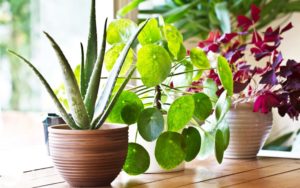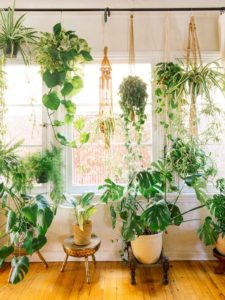As the heat of summer starts to wind down and autumn cool sets in, it’s time we begin prepping houseplants for their return to the climate controlled indoors as they bid adieu to their outdoor summer vacation. We’ve put together some tips and tricks below to help your plants thrive better when adjusting to the indoors.

Plan Ahead and Be Selective
When it comes to “who” to bring inside, it’s best to plan early before the need arrives to move your houseplants. One thing to consider when picking who stays out and who comes in is the overall health of the plant. If your plant has been struggling to stay alive outdoors, bringing it indoors to low humidity, dry heat and low light levels will increase the stress on it and you. As difficult as saying goodbye to our green friends can be, it’s usually best to put struggling plants in the compost pile and move on. As you’re selecting the healthiest houseplants you’d like to bring indoors, make sure you also consider the size of the plants and the space they’ll be taking over in your house. Will the plant need to be transplanted into a smaller container? Do you have enough room in your kitchen or living room for the width and height of your plant? Will it be receiving enough natural sun, or will it need supplemental light? These are just a few questions to consider as you’re picking who to bring indoors and who to let go of!
When To Move and Acclimation
While Arkansas summers can tend to drag on, our weather can also jump all over the charts within one week and summer abruptly ends, and fall begins! A general rule for bringing in sensitive houseplants is as the evenings start to drop to 50 degrees or cooler, it’s time to move them inside. Making the move indoors more gradual will help with climate shock. Acclimating your plants for the big move will greatly increase their chances of survival. For the first few days of cooler temps, moving your plants to a shadier area, or to a covered patio is a good idea. The plants will still experience similar humidities but will start to get used to not having that bright sunlight. From there, if your plants are receptive to the change, you can bring the containers inside in the evening and move them back outside in the morning. Gradually the time the plant is indoors until it’s their full time. Take into consideration whether your plants are shade-loving or sun-loving. Sun loving annuals and topicals will need a nice sunny window to be close to, but not too close when the temperatures get close to freezing. Those low-light plants can find homes around your house. Even if you do not have enough room to bring all your favorite plants, keeping plants in a garage space can be enough to ensure they will make it to the warmer months in the spring. Adding a humidifier close to where your plants could be a great help if the plants you have are considered tropical. One last thing to consider is maybe giving some of our leggier, flowering plants a haircut. This will allow plants to conserve their energy and be able to bounce back stronger in the warmer months.
Winter Watering
As much as we love to nurture our plants, their watering needs will go down during the winter months. Using a Good Earth moisture meter will help you be able to determine if they need watering. A good rule of thumb is to check your plants weekly. Without the sun and heat, you may only need to water weekly or bi-weekly.
Removing Pests
An important first step when bringing outdoor plants back inside is to check for hitchhiking bugs and pests. Check for mold and moss on the exterior of your pot, if not transplanting into a new container, and inspect the plants for mealybugs, aphids, spider mites, scale and the like. These pests, if brought indoors, multiply rapidly and can infect other plants. Check the stems and leaves, and push around the top layer of soil to see if insects or pests appear. If you notice any unwanted mites and bugs, first hose down the plant thoroughly but gently then apply
insecticidal soap or neem oil and let it dry to destroy pests and their eggs. If you notice any ants or small bugs living in the soil, you may want to either soak the soil to assess the severity of infestation or re-pot the plant completely. To check for pests by soaking, put the pot in a tub of lukewarm water for about 15 minutes and watch unwanted pests living in the soil scramble to the surface in search of air. You may want to re-pot your plant if ants or a few small bugs appear.
Prepping The Space 
As “moving day” approaches, go about your home and decide ahead of time where each plant will be placed. By pre-determining the spaces your new guests will occupy, you can move furniture, purchase or build plant stands, and analyze how much light places get throughout the day. Placing plants that need full sun near south-facing windows and plants that only need partial sun in an east- or west-facing window, will help them thrive better in their new lighting situations. Most plants experience some yellowing of leaves and tend to drop a few as they transition indoors, this is normal! However, if they lose a significant amount of leaves within the first few weeks, you may need to consider moving them to or from a light source or away from a drafty area. Adding an artificial light source, such as a grow lamp, may also solve this problem if your plant was previously placed outdoors in a sunny location.
Watering
Proper watering of your plants is essential to their overall health! While outdoors, your plants dry out more frequently due to heat and intense sunlight, but when moved indoors, their watering needs will significantly decrease. One of the best ways to make sure you’re not over or underwatering your houseplants is with a moisture meter. Moisture meters are simple to use and excellent determiners of watering needs- we love them at the shop!
By following the steps above you can plan, prepare, and perform the move of your outdoor plants to the great indoors with confidence! Houseplants can add great texture and fun to your indoor space. If you need more tips and tricks to help your plants thrive, check out this previous post on houseplants from one of our gardening experts!
Posted on October 14, 2024 by Jennifer Gibson - Seasonal Tips, Houseplants

